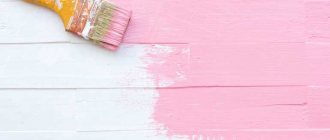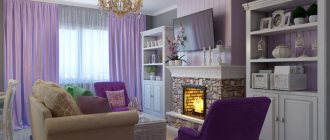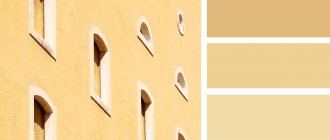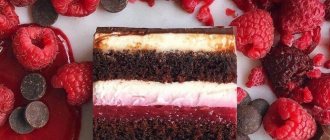» How to get color » How to get blue color and its shades
How to get blue by mixing paint colors? Unfortunately, this is not a feasible task, however, you can get shades of it. Photo.
Blue is the primary color, so to create all shades of blue you will need blue paint. No mixing of other colors will give a blue tint, so the presence of this paint in the set is a must!
How to get a classic blue color when mixing paint?
Even in a set of 12 shades, you may not have the classic blue paint, the so-called royal shade. For example, in acrylic paints the main blue color is ultramarine: a very bright and dark shade with a slight purple undertone. To obtain a lighter blue paint, mix it with white: 3 parts blue and 1 part white. The more white, the lighter the tone, up to a sky blue hue.
And to get a moderately saturated tone, dark saturated paint should be mixed with turquoise.
Tips for Mixing Colors
To obtain the ideal color, you need to ensure that all ingredients are similar in chemical composition. Otherwise, the mass may separate, leaving unmixed veins. It is also important to use high-quality paints, because others begin to darken and turn gray over time. Oil dyes are very susceptible to changes - it is better to first try the work on a small area and evaluate the effect after a couple of days. Artists note: the fewer colors were combined, the better the result will be, and the lower the risk of fading and peeling of the finished decor.
How to get gray-blue color by mixing colors?
The complementary color for blue is orange, and when these color spectrums are mixed, the result should be gray. If you mix orange and blue paints, you get a formidable mass of indefinite color. However, if you replace orange with brown and mix it with the main blue in the proportion of 2 parts blue and 1 brown, you get a dark, complex gray-blue color. With the addition of white, the color takes on a more pronounced gray-blue tint.
What is base color
There are three pigments independent of each other, which cannot be imagined as a mixture of others. Blue, yellow and red are the basis for creating other tones. You can mix them with each other. But obtaining a basic base by combining other colors is an impossible task. That is why these tones must be present in any palette. If one of them runs out, the only option is to purchase new paint.
However, many shades of blue can be reproduced by mixing with red, yellow and their variations - 180. But this is according to official data. I think artists create a lot more of them. In music, too, there are only seven notes.
How to get blue color by mixing paints?
Any shade of blue can be obtained with a significant admixture of white. First you need to get the main shade, and then add white paint.
How to combine blue color and its shades.
How to get other colors and their shades: theory and practice. Click on the icon.
One comment on “How to get blue and its shades”
- Sergei the omnipresent
April 22, 2021, 12:56
Well done
Acrylic paints
Acrylic paints are the most beloved and popular among the vast majority of designers. These paints are very easy to work with. The finished acrylic-based coating has good water-repellent properties. Working with acrylic dyes requires following certain rules:
- The surface on which acrylic paint is applied must be smooth and perfectly level. It must first be thoroughly sanded.
- It is very important not to let the paint dry out.
- To make the blue color opaque, the paint must be used undiluted. On the contrary, to make the color transparent, a small amount of water is added to it.
- In order to choose the right color, slowly and carefully, you can use a special thinner for acrylic paints. In this case, the materials will not dry out as quickly.
- Apply the coating to the surface using the tip of a brush.
- Mix different colors using a separate clean brush. Different tones should be directed towards each other.
Traditionally, you can add white paint to get a lighter shade, and black paint to get darker tones.
Getting to know the color blue
Why is blue called irreplaceable? Because it is one of the three primary colors that cannot be obtained by mixing other colors. That's why our today's hero is so popular. Red, yellow and blue are the three pillars on which any artist’s palette rests. Of course, there are craftsmen who exclude everything bluish from their work, but this is very rare. Even very hot works have cold spots. Ultramarine colors are always classified as cool tones. And for warm to become hot, cold contrast is simply necessary.
In this case, you cannot do without blue. Many famous artists idolized our hero. Their paintings sang hymns to ultramarine. Among such masters are Nicholas Roerich, Claude Monet, Mikhail Vrubel, Pablo Picasso. Imagine for a moment Aivazovsky’s paintings without blue. This will simply destroy the great seascapes that delight millions of fans around the world. The same can be said about other equally famous marine and landscape painters.
It turns out that you can’t do without blue, but it cannot be obtained by mixing other colors. What to do if you want to draw, but there is no blue? Here are some options to solve this problem:
- Use a blue background for your work. This can be any surface of this color that is suitable for the selected paints. For watercolors and gouache - paper, cardboard or plywood. For oil and acrylic paints - canvas primed with blue primer, wall, metal surface or colored glass.
- A universal way is to switch to a monochrome writing style. What it is? When a picture is painted in one color. Use the colors you have. Try with your creation to make viewers see blue in red or yellow. The task is very difficult, but quite feasible, which has made more than a dozen authors famous throughout the world for such works.
- For those who are especially gifted and love unsolvable puzzles, there is another way. The painting is done without our hero in warm and hot colors. To make viewers believe that he is still in the picture, various compositional, technical and color tricks are used. This option does not limit the authors' flight of fancy. Many achieve such an effect that it is difficult to believe that the painting was made without the color blue.
We hope that the acquaintance took place. Now it’s a good idea to talk about how to use blue to the fullest in our creativity.
How to mix paints correctly.
When doing painting and finishing work, you often have to mix paints in order to achieve one shade or another. In this article we will talk about how to properly mix paints and varnishes, as well as how to use colors correctly.
Variety of colors to create the desired shade
Features of mixing paints and varnishes
The photo shows the simplest color combinations
The color palette presented in the range of paints and varnishes is achieved by mixing 2 achromatic colors: black and white, and by mixing 3 chromatic colors: red, yellow and blue.
Having sufficient knowledge in the field of coloring, you can create any or almost any shade. If knowledge in this area is not enough, a ready-made paint mixing table can be used. This table is an effective help both for a novice painter and for a professional engaged in color selection when tinting automobile and other equally popular paints.
For photo-tinting of acrylic composition at home
For more correct mixing of paint colors, tables have been developed for different types of paints and varnishes. This approach to the development of tables is explained by the fact that different paints and varnishes are characterized by different mixing intensities. Therefore, the finished result, depending on the paint base, may vary.
So, let's take a closer look at how different types of paints are mixed.
Mixing different types of paints
It’s easy to achieve the desired shade with your own hands
- Water-based paints and varnishes are the easiest to combine to obtain new shades . Water-dispersive compositions are sold in a basic white color design, therefore, it is not the paints that will have to be mixed, but the colors. Kohler (pigment concentrate) is a liquid or powder of rich color. By adding this or that amount of color to the white composition, you can achieve the desired shade at the output. Before applying the color, pay attention to the instructions on its packaging and make sure that the product is compatible with the paintwork material you are using.
Important: The shade obtained in a bucket of water-dispersion composition will always look darker and more saturated than the shade of dried paint.
- Oil paints are more difficult to mix than water-based paints . The fact is that there are no dyes for such compositions, so paintwork materials of different shades will have to be combined. First, you need to decide on the composition of the paint, since there are modifications that can be diluted with drying oil or white spirit, and along with them you can purchase nitro enamels, which contain other organic solvents. Of course, in no case should you combine different compositions to obtain one color or another. In order not to make a mistake in selecting paints for subsequent combination, it is advisable to be guided by the tables given in this article or on the websites of paint and varnish manufacturers.
- Acrylic paints are combined to obtain the desired shade in accordance with the table . Mixing these paints is not difficult, since their one-component structure quickly acquires a uniform color. Another advantage of working with such a composition is the wide range of colors of acrylic paints and varnishes on the market. As a result, you can purchase everything you need to create the rarest and most extraordinary shades.
- It makes no sense to mix mineral paints, including silicate, cement and lime compounds, with each other, since the shade can be obtained by combining various pigments . You can do this either at home with your own hands, or in specialized stores, where you can use the computer shade selection service.
Types of pigments
The photo shows an assortment of pigmenting components
Each color corresponds to one or another pigment or group of pigments.
Understanding the types of pigments, you can independently combine paints of the desired color in your home workshop or garage.
- White color can be obtained using titanium, zinc or lead white. When coloring white mineral paints, lime, kaolin or barite are used as pigments.
- Black and, as a result, gray paints are produced using carbon (soot or coal). Gas soot, made by combining resins, tar, petroleum oil and gas, can also be used as a pigment. When producing water-based paints and varnishes, a color based on finely ground charcoal or burnt bone is used for blackening.
- Brown colors are made on the basis of potassium permanganate, brown umber or kolkotar. Of course, such colors can be obtained by mixing other pigments, since this color is not the main one.
- Red pigment for addition to mineral paints is made using mercury cinnabar or surrogates, including chrome or antimony cinnabar. Red ocher, red lead, iron cinnabar, etc. can also be used. In the industrial preparation of paints and varnishes, mineral varnish or, as it is also called, pincooler, has found application. This is finely ground glass, colored red with chrome-tin salt.
- The yellow color is made using ocher. As a rule, these are the most accessible and inexpensive dyes. A more saturated yellow color is produced by lead oxide (massicot), cadmium zinc or cobalt bile.
- Blue pigments are made from finely ground glass colored with cobalt-potassium silicate. Cobalt blue is used for the preparation of paints and varnishes containing organic solvents.
Other colors are achieved by mixing the above pigments in various proportions.
Practical recommendations for combining colors
The photo shows a visual diagram of combining pigments for water-dispersion coatings
Now that we know what the instructions are for mixing different types of paintwork materials and when we know the features of the selection of pigments, we will consider the combinations through which the following shades can be obtained:
- green=yellow + blue;
- orange = yellow + red;
- apricot = red + white + ocher;
- lemon = yellow + green + white;
- brown = red + green;
- beige = brown + yellow + white;
- purple=red+blue;
- turquoise = blue + green;
- terracotta = orange + brown;
- tobacco = yellow + red + green + white;
- coffee with milk = red + brown + white;
- ocher = yellow + brown;
- black=red+green+blue.
Of course, this is a limited list of combinations. But it is more than enough to cope with cosmetic repairs in an apartment or country house.
Tip: When mixing ready-made pigments or paints, use a small white container. When combining compositions, write down the proportions used so that, having found the optimal combination, everything can be repeated again.
Automated tinting
The combination of pigments determines the shade of the paintwork
Is it possible to get the desired paint color quickly and without putting in too much effort? There is such an opportunity, since in most specialized stores you can order computer color selection in accordance with the paint manufacturer’s catalog.
This service is especially relevant when selecting shades for acrylic paints used for external and internal finishing works.
The process goes like this:
- The customer selects a suitable shade from the catalog.
- The seller inserts a bucket of basic white composition into the machine.
- The required shade is then entered into the software.
- The device automatically measures the required amount of pigments, which fall into a bucket with the base composition.
- Next, the contents of the bucket are thoroughly mixed until a one-component composition with the required shade is obtained. In older devices, mixing is done using a submersible mixer; in new installations, the shade is combined using a vibrating platform on which the bucket is fixed.
- The finished composition will need to be mixed again before use, but this time by hand.
The photo shows professional equipment for tinting decorative coatings
Naturally, the price of automatic tinting is higher than the cost of a similar process carried out manually at home. But it is in this case that you can count on the fact that the resulting shade will be identical to the sample you selected from the catalog.
How do pigments affect
The hair shaft contains a natural dye, which gives the final effect of coloring. Thus, dark strands are characterized by an increased presence of eumalin, which saturates the rod with brown and black pigment.
Light brown hair is rich in iron and can give off a greenish or copper tint. Red strands are enriched with feomalin, which gives them a red or yellowish color. And those with silver (gray hair) or whitish hair (albinism) do not have pigment or have it in small quantities.
When colorizing strands, in order to achieve the desired shade, you need to learn how to determine the dominant tone in the hair.
This information will help you choose the right paint color and get a more “ideal” shade. Professionals especially emphasize the importance of determining the dominant pigment at the beginning of coloring procedures.
This is due to the high probability that completely unnecessary shades may remain on the strands. To avoid such trouble, the initial color of the hair shaft is determined and unwanted tones that may appear after coloring are predicted.
To choose the right shade, take into account the following effects of pigments on hair:
- brunettes are advised to eliminate the appearance of a reddish tint using blue;
- It is important for brown-haired women to avoid the appearance of copper shades and green is perfect for this;
- For blondes, everything is often spoiled by an unpleasant yellow color scheme, which is removed with the help of purple.
Professional masters of the beauty industry, in order to completely eliminate the unwanted manifestation of pigment, use the opposite colors or mixtons to the chosen ones. If coloring will be carried out not in a salon, but at home, then it should only be professional paints.
A competent calculation of the ratio of ingredients and pigment neutralizer will ultimately show the desired result. Those who want to color their hair themselves should not forget that products from different brands are not suitable for mixing, since they are already a ready-made and balanced product.
See also: how to create the perfect color at home (video)
Countercolor color wheel rules
In the science of color, it is written that there are warm and cold shades: yellow, blue and red.
All other pigments are only derivatives of these three dominants, which are created by combining them in various proportions. Experts identify the following groups:
- secondary - formed by interaction with two basic colors in equal quantities;
- tertiary colors are the result of a combination of primary and secondary colors.
So, it is impossible to combine warm and cold colors. For example, platinum or ash tones are suitable for blondes with faded hair, and brown colors will suit those with dark hair with a calm pigment. In coloristics, colors move from one to another, changing gradually, without sudden changes.
Pigments placed on the opposite side are neutralizing countercolors. It is included in coloring to avoid unwanted shades that a dominant and natural pigment can give.
Each of the basic colors has its own countercolor, so red comes from green, blue from orange, yellow can be easily removed with plum. All combinations allow you to get a natural tone on your curls. And also do not mix purple with yellow or blue with orange.
Masters of hairdressing rely on these basic points in calorics. They know exactly which colors to mix and select the right shade based on the client’s eye pigment and dermis type.
Color mixing options to create shades of gray
When renovating a room, mixing black oil paint with white is the easiest and most effective way to achieve gray. But we must take into account that when drying, the color acquires a deeper saturation and becomes darker. Therefore, before starting work, the composition should be tested on a similar surface. One shade used on walls of different materials or textures can produce different visual effects.
To create more “live” tones you should:
- add a drop of blue or green to the created mixture to obtain cold mother-of-pearl;
- introduce a little yellow or ocher, which creates the illusion of warm ash;
- use antimony to give a metallic, silvery tint;
- combine gray with pink, thereby achieving a spectacular ash-copper tone.
ways to obtain different shades of gray
Working with paints from two or more manufacturers at the same time is not allowed. They vary in consistency, density and brightness, and this reduces the quality of the resulting mixture. The final adjustment of the color is made by adding a few drops of white to lighten or black pigment to obtain a darker shade.
Scheme for obtaining different shades of gray











